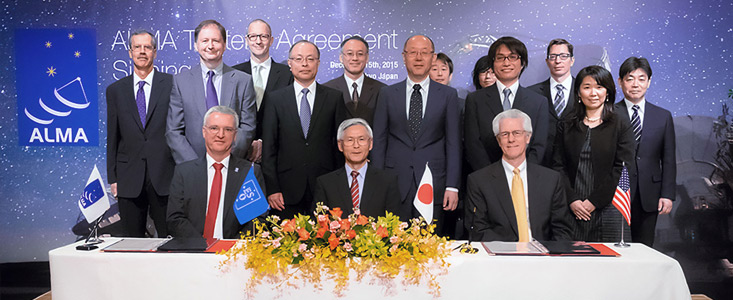Announcement
ALMA Trilateral Agreement Signed
18 December 2015
A trilateral agreement between ESO, the National Science Foundation (NSF) and the National Institutes of Natural Sciences (NINS), concerning the operation of ALMA was signed in Tokyo, Japan, on 15 December 2015. The contributions of the three international partners ensure the continued success of this transformational (sub-)millimetre observatory located on Chajnantor Plateau in northern Chile. The new agreement provides the framework for the long-term operations of ALMA over the next 20 years
Tim de Zeeuw, ESO Director General, Katsuhiko Sato, NINS President, and F. Fleming Crim, NSF Assistant Director (on behalf of France Córdova, NSF Director), represented the three partners at the ceremony and signed the ALMA Trilateral Agreement. Other staff members from ESO, the National Astronomical Observatory of Japan (NAOJ) and NSF were also in attendance.
The construction and first observations from ALMA were undertaken based on agreements signed in 2003 and 2004. The inauguration ceremony, held in 2013 (eso1312), marked the moment ALMA formally became a fully fledged observatory. Since then a flood of new discoveries and key insights have come from this uniquely powerful international observatory (eso1549, eso1436, eso1344).
“ALMA construction was started as a bilateral project between NSF and ESO and Japan joined soon after, when an additional agreement between all three parties was signed. This was a key step as it enabled ALMA to become a truly transformational facility. It also strengthened the partnership and enriched it with an additional scientific community and culture,” said Tim de Zeeuw. “The new tripartite agreement plays the vital role of cementing this successful global collaboration for the future.”
After the signing ceremony, the delegates from ESO and NSF were given a tour of the NAOJ headquarters under the guidance of Masa Hayashi, the Director General of NAOJ. They were shown the 4D2U theater, NAOJ Observatory History Museum, the TAMA300 gravitational wave detector, and the NAOJ Advanced Technology Center.
The new agreement signals the continuing trust and cooperation between ESO, NSF and NINS as ALMA makes the transition from construction into full science operations that are expected to last over three decades.
More Information
The Atacama Large Millimeter/submillimeter Array (ALMA), an international astronomy facility, is a partnership of ESO, the US National Science Foundation (NSF) and the National Institutes of Natural Sciences (NINS) of Japan in cooperation with the Republic of Chile. ALMA is funded by ESO on behalf of its Member States, by NSF in cooperation with the National Research Council of Canada (NRC) and the National Science Council of Taiwan (NSC) and by NINS in cooperation with the Academia Sinica (AS) in Taiwan and the Korea Astronomy and Space Science Institute (KASI).
ALMA construction and operations are led by ESO on behalf of its Member States; by the National Radio Astronomy Observatory (NRAO), managed by Associated Universities, Inc. (AUI), on behalf of North America; and by the National Astronomical Observatory of Japan (NAOJ) on behalf of East Asia. The Joint ALMA Observatory (JAO) provides the unified leadership and management of the construction, commissioning and operation of ALMA.
ESO is the foremost intergovernmental astronomy organisation in Europe and the world’s most productive ground-based astronomical observatory by far. It is supported by 16 countries: Austria, Belgium, Brazil, Czechia, Denmark, France, Finland, Germany, Italy, the Netherlands, Poland, Portugal, Spain, Sweden, Switzerland and the United Kingdom, along with the host state of Chile. ESO carries out an ambitious programme focused on the design, construction and operation of powerful ground-based observing facilities enabling astronomers to make important scientific discoveries. ESO also plays a leading role in promoting and organising cooperation in astronomical research. ESO operates three unique world-class observing sites in Chile: La Silla, Paranal and Chajnantor. At Paranal, ESO operates the Very Large Telescope, the world’s most advanced visible-light astronomical observatory and two survey telescopes. VISTA works in the infrared and is the world’s largest survey telescope and the VLT Survey Telescope is the largest telescope designed to exclusively survey the skies in visible light. ESO is a major partner in ALMA, the largest astronomical project in existence. And on Cerro Armazones, close to Paranal, ESO is building the 39-metre European Extremely Large Telescope, the E-ELT, which will become “the world’s biggest eye on the sky”.
Links
Contacts
Richard Hook
ESO Public Information Officer
Garching bei München, Germany
Tel: +49 89 3200 6655
Cell: +49 151 1537 3591
Email: rhook@eso.org
About the Announcement
| Id: | ann15097 |


